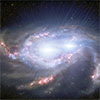| Jun 10, 2022 |
|
|
|
(Nanowerk News) Astronomers at Lund University in Sweden have found a group of stars in the Milky Way disk, that are most likely remnants from an unknown baby galaxy that was swallowed by the Milky Way over 10 billion years ago. Nothing like it has been discovered in the galaxy disk before.
|
|
After the Big Bang 13.8 billion years ago, space was a veritable Wild West. Stars formed inside huge gas clouds that collided and fused into larger and larger clouds. However, after a few billion years of space chaos, galaxy embryos became more stable, eventually evolving into well-ordered spiral galaxies, such as the Milky Way.
|
|
In a new study on the origins of the Milky Way, published in Astrophysical Journal (“An old, metal-rich accreted stellar component in the Milky Way stellar disk”), a research team has made a surprising discovery.
|
 |
| Two galaxies merging. (Illustration: International Gemini Observatory/NOIRLab/NSF/AURA/J. da Silva)
|
|
“We have found traces of a smaller galaxy that was swallowed by the Milky Way. This intergalactic relic was indirectly discovered through a population of ten billion-year-old stars in the Milky Way’s disk. This is the first time such old stars have been foundin the diskthat show signs of coming from another galaxy”, says Diane Feuillet, astronomer at Lund University who led the study.
|
|
Using data collected during the APOGEE (Apache Point Observatory Galactic Evolutionary Experiment) star survey, researchers were able to identify the stars in question. The ten billion-year-old celestial bodies were found to have a different elemental composition, with higher levels of iron and lower levels of aluminum than is standard for stars in the Milky Way disk. The scientists could therefore conclude that they must have formed in a much smaller galaxy than The Milky Way. Thanks to data from the Gaia space telescope, they were then able to calculate the orbits of the stars.
|
|
“We already know that the Milky Way has devoured other smaller galaxies. But this is the first proof that stars from such galaxies have ended up in the Milky Way’s disk. We were very surprised”, says Sofia Feltzing, one of the co-authors of the study.
|
|
The Milky Way consists of three major parts: a disk (where our sun is), a halo and a central part. In the halo, astronomers have long been able to identify stars from other galaxies. For example, the Gaia satellite has shown that a larger galaxy – Gaia Enceladus –fell inabout ten billion years ago. The new study shows for the first time that there are also remnants of other ancient galaxies in the Milky Way’s disk.
|
|
“The results will be useful for the models of galaxy formation that astronomers work with. The study also shows the turbulent history of our galaxy and that stars that move like our sun can come from other galaxies”, concludes Diane Feuillet.
|


